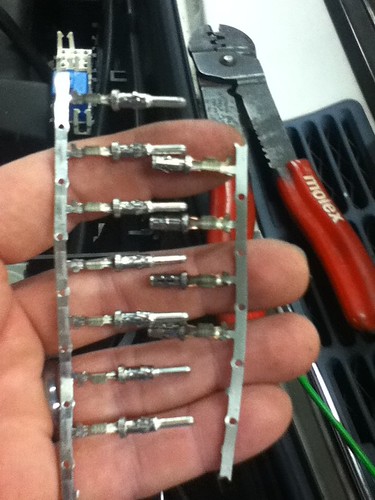Those solder splices are pretty cool. I like how they incorporate a strain relief into it, as most cables I see fail not because of the crimp or solder connection, but because the vibration rattled the shit out of the stranded wire right behind the connection; there was no strain relief.
I use to design and build wire harnesses (was a long term temp job a few years ago) for high vibration water filtration machines. I had no technical education or experience when it came to electricals and wiring, but just using the internet, a bit of logic and common sense, and inspection of what other electrical wiring mfg does on harsh enviroment/high vibration connections as my resources, I was able to get the job done well. I attempted to follow crimping procedures set in automotive standards (techniques and tests), and so far none of the machines have had any issues. I prefer crimps over solder, but that is because I am confident in my ability to crimp connections.
For uninsulated crimps, I found a great hand crimper made by Molex. Part number 63811-1000. Insulated crimps are trash to me. Digi-key has them for $35 or something, and it covers almost every wire size except for battery cables and large ground straps. Makes as perfect "B" type crimps as you can reliably do with your hand.

I don't usually like to use butt connectors, and like Nando, I prefer to run a new strand of wire. But in the event I can't, I use these oem butt connectors (61138353746,61138353747,61138353748.) with normal olefin shrink tubing or adhesive lined shrink to provide a weather proof seal, depending on the environment, and as a strain relief.

PVC insulated wires suck ass. XLPE much better :)
my 2c.
Derek
DedericMS
I use to design and build wire harnesses (was a long term temp job a few years ago) for high vibration water filtration machines. I had no technical education or experience when it came to electricals and wiring, but just using the internet, a bit of logic and common sense, and inspection of what other electrical wiring mfg does on harsh enviroment/high vibration connections as my resources, I was able to get the job done well. I attempted to follow crimping procedures set in automotive standards (techniques and tests), and so far none of the machines have had any issues. I prefer crimps over solder, but that is because I am confident in my ability to crimp connections.
For uninsulated crimps, I found a great hand crimper made by Molex. Part number 63811-1000. Insulated crimps are trash to me. Digi-key has them for $35 or something, and it covers almost every wire size except for battery cables and large ground straps. Makes as perfect "B" type crimps as you can reliably do with your hand.

I don't usually like to use butt connectors, and like Nando, I prefer to run a new strand of wire. But in the event I can't, I use these oem butt connectors (61138353746,61138353747,61138353748.) with normal olefin shrink tubing or adhesive lined shrink to provide a weather proof seal, depending on the environment, and as a strain relief.
PVC insulated wires suck ass. XLPE much better :)
my 2c.
Derek
DedericMS









Comment